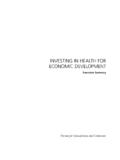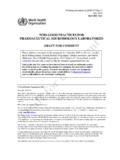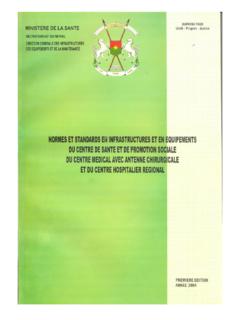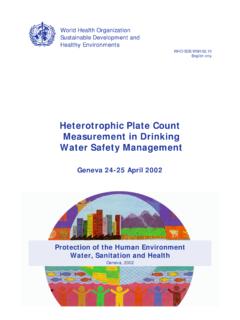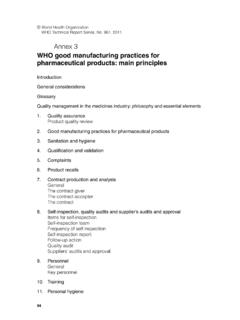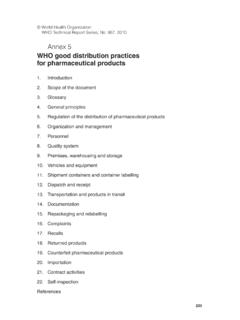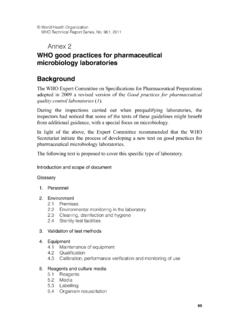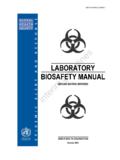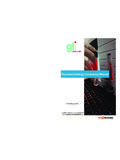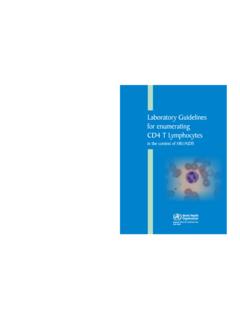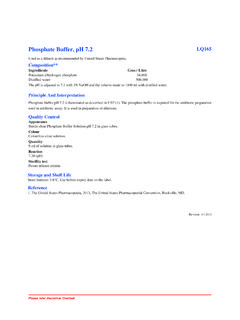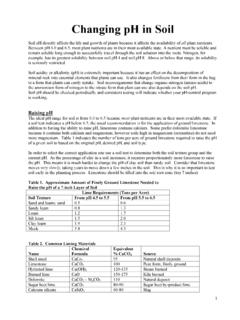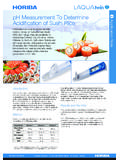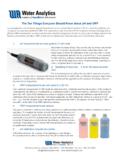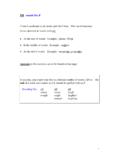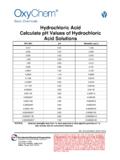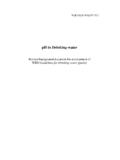Transcription of pH in Drinking-water - World Health Organization
1 WHO/SDE/ English only pH in Drinking-water Background document for development of WHO Guidelines for Drinking-water Quality _____. Originally published in Guidelines for Drinking-water quality, 2nd ed. Vol. 2. Health criteria and other supporting information. World Health Organization , Geneva, 1996. World Health Organization 2003. All rights reserved. Publications of the World Health Organization can be obtained from Marketing and Dissemination, World Health Organization , 20 Avenue Appia, 1211 Geneva 27, Switzerland (tel: +41. 22 791 2476; fax: +41 22 791 4857; email: Requests for permission to reproduce or translate WHO publications - whether for sale or for noncommercial distribution - should be addressed to Publications, at the above address (fax: +41 22.))
2 791 4806; email: The designations employed and the presentation of the material in this publication do not imply the expression of any opinion whatsoever on the part of the World Health Organization concerning the legal status of any country, territory, city or area or of its authorities, or concerning the delimitation of its frontiers or boundaries. The mention of specific companies or of certain manufacturers' products does not imply that they are endorsed or recommended by the World Health Organization in preference to others of a similar nature that are not mentioned.
3 Errors and omissions excepted, the names of proprietary products are distinguished by initial capital letters. The World Health Organization does not warrant that the information contained in this publication is complete and correct and shall not be liable for any damages incurred as a result of its use Preface One of the primary goals of WHO and its member states is that all people, whatever their stage of development and their social and economic conditions, have the right to have access to an adequate supply of safe drinking water . A major WHO function to achieve such goals is the responsibility to propose regulations, and to make recommendations with respect to international Health matters.
4 The first WHO document dealing specifically with public Drinking-water quality was published in 1958 as International Standards for Drinking-water . It was subsequently revised in 1963 and in 1971 under the same title. In 1984 1985, the first edition of the WHO Guidelines for Drinking-water quality (GDWQ) was published in three volumes: Volume 1, Recommendations; Volume 2, Health criteria and other supporting information; and Volume 3, Surveillance and control of community supplies. Second editions of these volumes were published in 1993, 1996 and 1997, respectively. Addenda to Volumes 1 and 2 of the second edition were published in 1998, addressing selected chemicals.
5 An addendum on microbiological aspects reviewing selected microorganisms was published in 2002. The GDWQ are subject to a rolling revision process. Through this process, microbial, chemical and radiological aspects of Drinking-water are subject to periodic review, and documentation related to aspects of protection and control of public drinking - water quality is accordingly prepared/updated. Since the first edition of the GDWQ, WHO has published information on Health criteria and other supporting information to the GDWQ, describing the approaches used in deriving guideline values and presenting critical reviews and evaluations of the effects on human Health of the substances or contaminants examined in drinking - water .
6 For each chemical contaminant or substance considered, a lead institution prepared a Health criteria document evaluating the risks for human Health from exposure to the particular chemical in Drinking-water . Institutions from Canada, Denmark, Finland, France, Germany, Italy, Japan, Netherlands, Norway, Poland, Sweden, United Kingdom and United States of America prepared the requested Health criteria documents. Under the responsibility of the coordinators for a group of chemicals considered in the guidelines, the draft Health criteria documents were submitted to a number of scientific institutions and selected experts for peer review.
7 Comments were taken into consideration by the coordinators and authors before the documents were submitted for final evaluation by the experts meetings. A final task force meeting reviewed the Health risk assessments and public and peer review comments and, where appropriate, decided upon guideline values. During preparation of the third edition of the GDWQ, it was decided to include a public review via the World wide web in the process of development of the Health criteria documents. During the preparation of Health criteria documents and at experts meetings, careful consideration was given to information available in previous risk assessments carried out by the International Programme on Chemical Safety, in its Environmental Health Criteria monographs and Concise International Chemical Assessment Documents, the International Agency for Research on Cancer, the joint FAO/WHO Meetings on Pesticide Residues, and the joint FAO/WHO Expert Committee on Food Additives (which evaluates contaminants such as lead, cadmium.)
8 Nitrate and nitrite in addition to food additives). Further up-to-date information on the GDWQ and the process of their development is available on the WHO internet site and in the current edition of the GDWQ. Acknowledgements The work of the following coordinators was crucial in the development of this background document for development of WHO Guidelines for Drinking-water quality: Fawell, water Research Centre, United Kingdom (inorganic constituents). U. Lund, water Quality Institute, Denmark (organic constituents and pesticides). B. Mintz, Environmental Protection Agency, USA.
9 (disinfectants and disinfectant by-products). The WHO coordinators were as follows: Headquarters: H. Galal-Gorchev, International Programme on Chemical Safety R. Helmer, Division of Environmental Health Regional Office for Europe: X. Bonnefoy, Environment and Health O. Espinoza, Environment and Health Ms Marla Sheffer of Ottawa, Canada, was responsible for the scientific editing of the document. The efforts of all who helped in the preparation and finalization of this document, including those who drafted and peer reviewed drafts, are gratefully acknowledged. The convening of the experts meetings was made possible by the financial support afforded to WHO by the Danish International Development Agency (DANIDA), Norwegian Agency for Development Cooperation (NORAD), the United Kingdom Overseas Development Administration (ODA) and the water Services Association in the United Kingdom, the Swedish International Development Authority (SIDA), and the following sponsoring countries: Belgium, Canada, France, Italy, Japan, Netherlands, United Kingdom of Great Britain and Northern Ireland and United States of America.
10 GENERAL DESCRIPTION. The pH of a solution is the negative common logarithm of the hydrogen ion activity: pH = -log (H+). In dilute solutions, the hydrogen ion activity is approximately equal to the hydrogen ion concentration. The pH of water is a measure of the acid base equilibrium and, in most natural waters, is controlled by the carbon dioxide bicarbonate carbonate equilibrium system. An increased carbon dioxide concentration will therefore lower pH, whereas a decrease will cause it to rise. Temperature will also affect the equilibria and the pH. In pure water , a decrease in pH of about occurs as the temperature is raised by 25 C.
